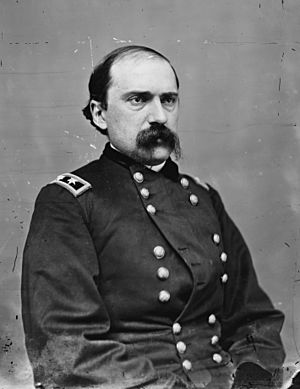Edward M. McCook facts for kids
Quick facts for kids
Edward M. McCook
|
|
|---|---|
 |
|
| 5th and 7th Governor of the Territory of Colorado | |
| In office June 19, 1874 – March 29, 1875 |
|
| Preceded by | Samuel Hitt Elbert |
| Succeeded by | John Long Routt |
| In office June 14, 1869 – 1873 |
|
| Preceded by | Alexander Cameron Hunt |
| Succeeded by | Samuel Hitt Elbert |
| 2nd United States Minister to Hawaii | |
| In office July 26, 1866 – December 5, 1868 |
|
| President | Andrew Johnson |
| Preceded by | James McBride |
| Succeeded by | Henry A. Peirce |
| Personal details | |
| Born | June 15, 1833 Steubenville, Ohio |
| Died | September 9, 1909 (aged 76) Chicago, Illinois |
| Resting place | Union Cemetery-Beatty Park, Steubenville, Ohio |
| Signature | |
| Military service | |
| Allegiance | United States of America Union |
| Branch/service | United States Army Union Army |
| Years of service | 1861–1866 |
| Rank | |
| Commands | 2nd Indiana Cavalry Cav Brigade / II Corps Division / (Western) Cavalry Corps |
| Battles/wars | American Civil War |
Edward Moody McCook (born June 15, 1833 – died September 9, 1909) was an important American figure. He was a lawyer and a politician. He also served as a brave general in the American Civil War. Later, he became a diplomat and the Governor of the Colorado Territory. He came from the famous "Fighting McCooks" family. Many of his relatives were also officers and generals during the war.
Early Life and First Jobs
Edward McCook was born in Steubenville, Ohio, in 1833. When he was young, he moved to the Kansas Territory. There, he became a lawyer. In 1859, he joined the exciting Pike's Peak Gold Rush. He even represented the Pikes Peak area in the Kansas government.
Serving in the Civil War
When the Civil War began in 1861, McCook went to Washington, D.C.. For a while, he worked as a secret agent for the government. He gathered important information for the military. Then, he joined the army as a cavalry lieutenant.
- Rising Through the Ranks
He became a Captain in the 2nd Indiana Cavalry. By mid-1862, he was a Colonel. McCook led a cavalry brigade at the Battle of Perryville. He also commanded a division at the Battle of Chickamauga.
- Battles and Raids
On April 27, 1864, he was promoted to brigadier general. He led the First Cavalry Division in the Army of the Cumberland. His 3,600 cavalrymen cut the Macon & Western Railroad in July 1864. This was part of the Atlanta Campaign. One goal was to free prisoners at Andersonville Prison.
However, McCook's forces were defeated by Confederate cavalry. This happened at the Battle of Brown's Mill on July 30. He lost many men and horses. McCook then marched to Tennessee to help George Henry Thomas. He fought well in the Franklin–Nashville campaign.
- End of the War
In March and April 1865, the war was ending. McCook led the First Division in Wilson's Raid. This raid went through Alabama and Georgia. He also fought at the Battle of Selma. Here, the Union cavalry defeated Nathan Bedford Forrest.
In early May, McCook's division went to Florida. Their job was to bring federal control back to the state. On May 13, the last Confederate troops in Florida surrendered to McCook. On May 20, McCook read Abraham Lincoln’s Emancipation Proclamation in Tallahassee. This officially ended slavery in Florida. His soldiers then raised the U.S. flag over the state capitol.
- Military Achievements
McCook earned the rank of brevet major general by the end of the war. His superior, James H. Wilson, praised him. McCook was not a professional soldier, but he was brave and effective. He received five special promotions for his courage and excellent service.
After the War
After the war, McCook left the army in 1866. He returned to civilian life.
- Diplomat in Hawaii
President Andrew Johnson appointed McCook as the U.S. Minister to the Kingdom of Hawaii. He served in this role from 1866 to 1868.
- Governor of Colorado
In 1869, President Ulysses S. Grant appointed McCook as Governor of the Territory of Colorado. Some people, like Jerome B. Chaffee, did not support this choice. As governor, McCook signed laws that created Colorado Agricultural College. He was also one of the first governors to support women's suffrage, which means women's right to vote. He was a member of the Republican National Committee in 1872.
- Business Success
McCook left the governorship in 1875. He then focused on business. He became very wealthy from smart investments. These included real estate, mining, and new European telephone companies. For a time, he paid more taxes than anyone else in Colorado.
Edward McCook died in Chicago, Illinois, and is buried in Union Cemetery in Steubenville. The city of McCook, Nebraska, is named after his cousin, Alexander McDowell McCook.

